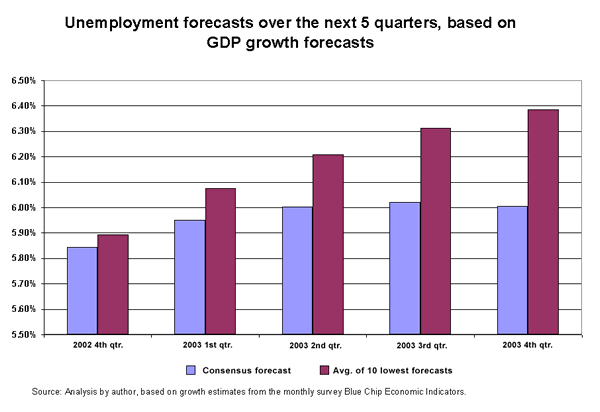Snapshot for November 27, 2002.
Even optimistic view sees high unemployment next year
A critically important debate is underway among national policymakers over the question: Is there or is there not a need for the government to take action to stimulate more economic growth? One view maintains that our economic fundamentals are solidly in place and therefore adequate growth will return soon, bringing with it faster job growth and lower unemployment.
But the figure below challenges that view. It shows two forecasts of unemployment through 2003, one somewhat more optimistic than the other. Each forecast is derived from a simple model relating the change in the unemployment rate to GDP growth. Growth estimates are drawn from the latest Blue Chip Economic Indicators, a widely watched monthly survey of leading economists.

The Blue Chip Consensus Forecast predicts that GDP will grow at a fairly strong annualized rate of 3.7% by next year’s last quarter. Even under this scenario, unemployment rises to 6% by the second quarter of 2003 and stays there throughout the year. Since the Blue Chip Consensus Forecast has erred on the high side of late, we also plot the jobless rate that would be derived from the average of the 10 lowest growth forecasts by surveyed economists. Under this slower-growth path, unemployment climbs to 6.4% by the last quarter of 2003.
Even in the more optimistic growth scenario, the jobless rate will stay too high to lift employment and earnings opportunities for many workers: recall that in 2001, when unemployment climbed less than one percentage point to 4.8%, poverty rose and most families saw their income fall. Thus, Congress and the Bush administration need to fret less about whether stimulus is needed and more about what type of stimulus will be most likely to generate faster growth.
Data note: GDP growth forecasts are related to changes in the unemployment rate using an analytic model presented in a forthcoming EPI working paper, “Another Look at Where Unemployment is Headed,” by economist Jared Bernstein. For a draft copy, email the author at jbernstein@epinet.org.
This week’s Snapshot by EPI Research Co-Director and economist Jared Bernstein.
Check out the archive for past Economic Snapshots.
Preferred Citation: Economic Policy Institute, “Economic Snapshots, [insert date].” Washington, D.C.: Economic Policy Institute, 2002.
